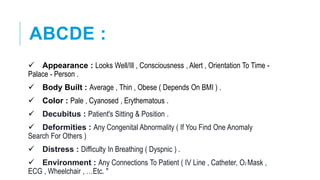general examination medical and nursing s.pptx
- 1. 3RD LECTURE RESPIRATORY SKILLS GENERAL EXAMINATION OF RESPIRATORY CASE Dr Muneer Bashoaib
- 2. PREPARING FOR PHYSICAL EXAMINATION - Introduce Yourself . - Take Permission . - Explain What You Are Going To Do . - Maintain Privacy . - Wash Your Hand . - Exposure ( Full Exposure Of Trunk ) , Position ( Sitting OR Semi-Sitting Position 45o ) .
- 7. ABCDE : ’ā╝ Appearance : Looks Well/Ill , Consciousness , Alert , Orientation To Time - Palace - Person . ’ā╝ Body Built : Average , Thin , Obese ( Depends On BMI ) . ’ā╝ Color : Pale , Cyanosed , Erythematous . ’ā╝ Decubitus : Patient's Sitting & Position . ’ā╝ Deformities : Any Congenital Abnormality ( If You Find One Anomaly Search For Others ) ’ā╝ Distress : Difficulty In Breathing ( Dyspnic ) . ’ā╝ Environment : Any Connections To Patient ( IV Line , Catheter, O2 Mask , ECG , Wheelchair , ŌĆ”Etc. "
- 8. VITAL SIGNS
- 13. NECK Neck vein >>Engorged and pulsatile neck veins (due to cor pulmonale) or engorged non-pulsatile veins in SVC obstruction. ’ā╝JVP >> raised in pulmonary hypertension , tension pneumothorax or large pulmonary embolism , superior vena cava obstruction ’ā╝Lymph node >> sarcoidosis , malignancy , TB , Lymphoma ’ā╝ using of accessory muscles ’ā╝Trachea
- 14. HAND ŌĆó Nicotine staining in nails (may be associated with bronchial carcinoma). ŌĆó Clubbing. ŌĆó Cyanosis. ŌĆó Wasting (due to involvement of lower trunk of brachial plexus by bronchial carcinoma, C8 and T1 lesions). ŌĆó Pulse: Tachycardia, pulsus paradoxus (due to severe obstructive airway disease), high volume and bounding pulse (due to CO2 excess). ŌĆó Warm and sweaty hands (due to anoxic cor- pulmonale). ŌĆó Flapping tremor (due to severe respiratory failure and CO2 retention). ŌĆó Signs of other diseases such as joint deformity in rheumatoid arthritis, skin change in systemic sclerosis or dermatomyositis (which may cause DPLD).
- 17. HORNERŌĆÖS SYNDROME Wasting of the small muscles of the hands from lung cancer
- 18. LOWER LIMB - Skin Changes , Muscle Wasting , Loss Of Hair . - Edema : Pitting / Non-Pitting - Unilateral / Bilateral - Level . - Pulse : Femoral - Popliteal - Dorsalis Pedis - Posterior Tibial .
- 19. A Fig. Skin lesions associated with respiratory conditions. A Metastatic nodules of lung cancer. B Erythema nodosum on the shins in sarcoidosis B
- 20. Thanks



















